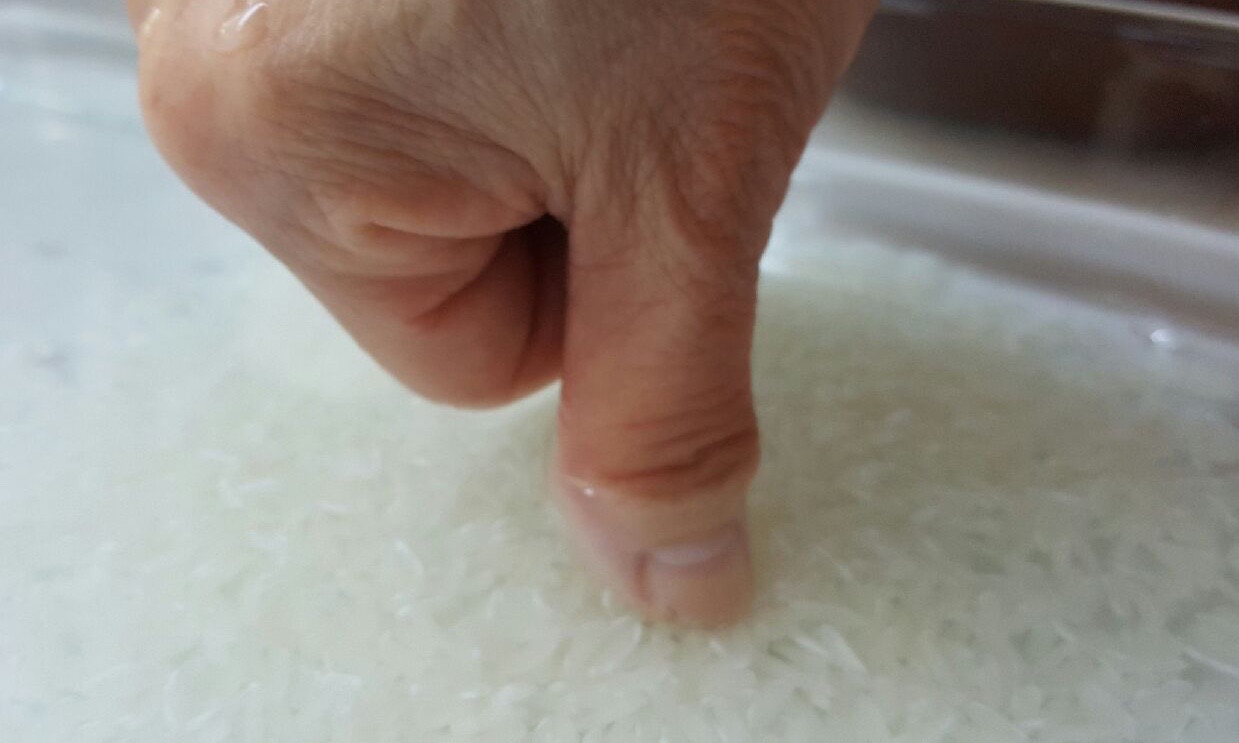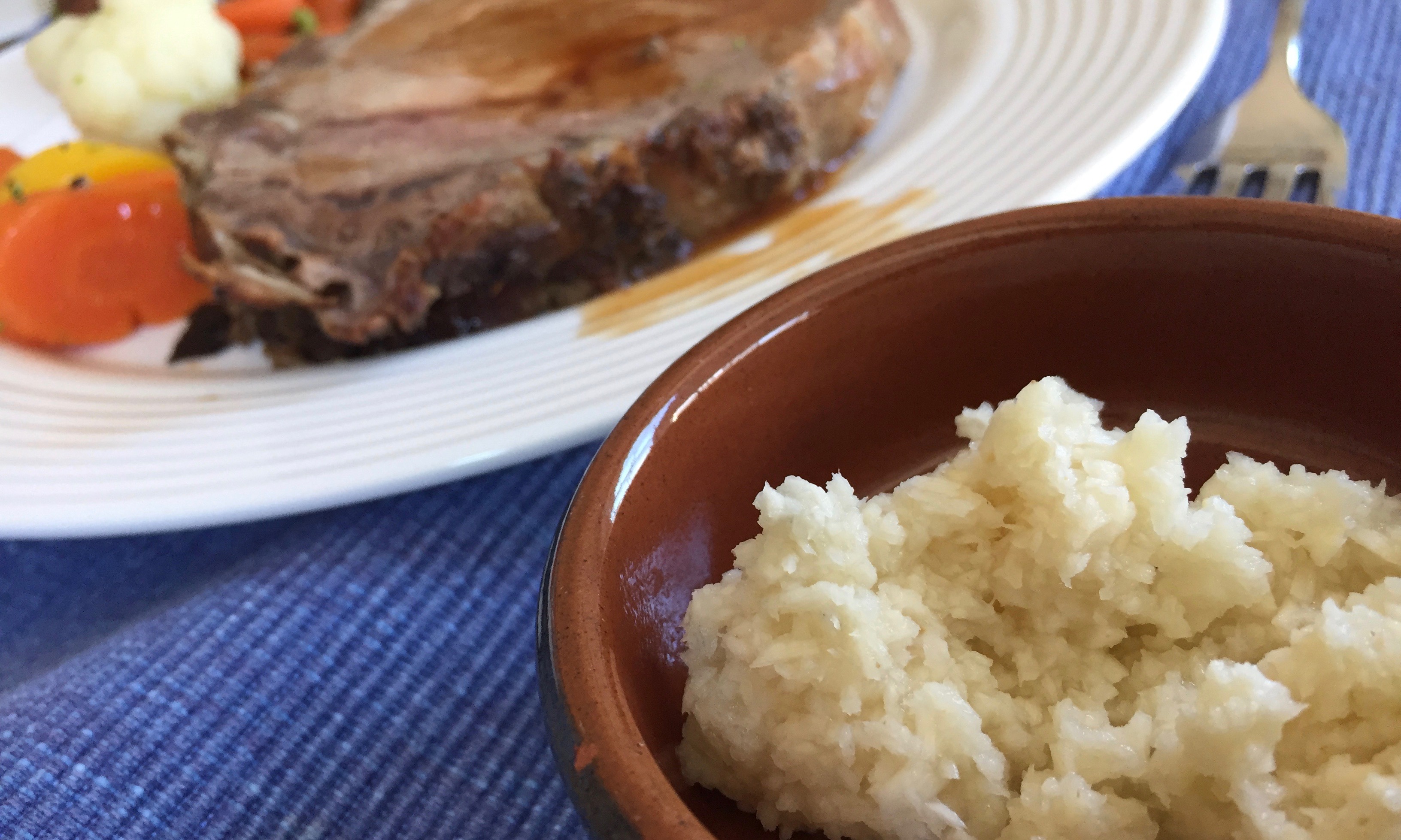Different folks cook rice differently. Someone from Mississippi told me she sprinkled the rice into boiling water. Italians cook it like they cook pasta, in a large pot of boiling water and then straining it. Some people stir the rice while boiling. Some add salt, oil, butter, milk or coconut milk. In Chinese restaurants, they serve steamed rice, but actually it’s just boiled rice.
Here’s the basics to cooking rice the way we were taught as children.
We don’t use standard measuring cups, we wash our rice, and we gauge how much water to put in with our fingers. This sounds complicated if you didn’t grow up eating rice everyday, but it’s worth understanding the basics.
For quick instructions on cooking rice in rice-cooker, stove top or microwave, click here.
Measuring rice
Today most of us use the Chinese rice cup, or muk, which comes with electric rice cookers. It’s equivalent to ¾ standard cup. In the old days, everyone had their own different rice cups. Way before we owned a rice cooker, when Mum ordered rice by the sack, carried by the delivery man over his shoulder and poured it into a large earthen jar, we measured our rice with an old Players cigarette tin. That was more like a full one cup measure. Our neighbors used a condensed milk tin.
How much rice to cook depends on whether you have big rice-eaters at home. In Cantonese, we call the hearty rice eaters fan tung, or rice tubs! (Hey the food tastes good with rice!) When growing up, Popo and the cooks delighted in fan tungs, who enjoyed their food, and could eat a lot of rice, even with just a little bit of sung, vegetable or meat dishes. Nothing gave the adults greater pleasure than to watch their growing children teem fan, or get another bowl of rice. In a family of six with hearty appetites, we would cook 4 or 5 cups of rice for family dinner.
But I’ve found that when I make dinner for friends, people tend not to eat as much rice nowadays, and I generally cook about 5 cups for a party of 10-15. One cup of uncooked rice yields 2 cups of cooked rice.
Washing rice
We also rinse our rice before cooking. This may sound obvious to Chinese and south east Asians, but I’ve found many friends surprised by this. In fact, today, they even sell rice rinser bowls. I doubt if those will sell in Singapore.
Run fingers through rice to stir up the talc and dust and then drain carefully. With practice, you won’t pour out the rice with the water. Rinse three or four times, until water is fairly clear as in third photo.
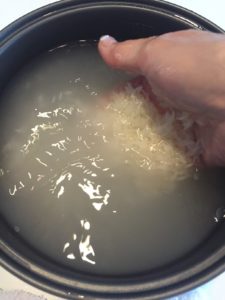
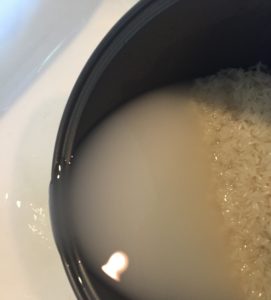
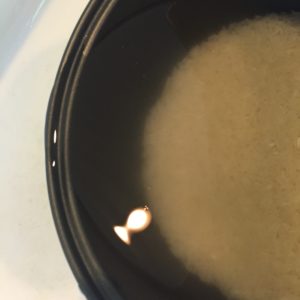
Measuring water with knuckle!
To determine how much water to add, we stick our thumb or index finger into the water tip touching the top of the rice, and estimate that the water level should be just below the first knuckle. Every Chinese person knows that! That’s how much water you need, whether it is 2 cups, or 6 cups of rice.
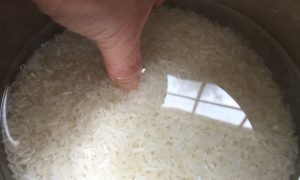
Once when we had to cook rice for 300 people using 5 or 6 rice cookers, I asked a Chinese friend from Vietnam if she knew how to use the gauge level in the rice cooker for 10 cups rice and she had no idea. “I only know how to stick my finger in it and measure,” she said. That’s when I learned that the levels marked in the rice cooker guides us to the level of water needed for the same amount of rice.
If you must be exact it’s about ¾ inch deep, measuring from top of rice to level of water.
However, because different varieties of rice absorb different amounts of water, you just have to try it when cooking rice from a new package the first time, and adjust with subsequent batches. Short grain rice, which the Taiwanese, Japanese, Korean and northerners prefer needs more water than long grain or Thai jasmine rice, which we in South East Asia and Cantonese favor.
Cooking the rice
The basic technique to cooking rice–whether it is in a rice-cooker, on the stove top or in the microwave–is to bring the water with the rice to a boil, and then lowering the heat to the lowest temperature (where there is very little or no bubbling), and letting it simmer to steam the rice until the water is absorbed and the rice grain is tender and cooked.
For instructions on cooking rice, click here.
Yummy burnt rice
Burnt rice–the rice that is cooked too long and hardened at the bottom of the pot–is something of a delicacy. Many people love its crispiness or chewiness; it even has a name–fan jiu–and people scrape the bottom of the pot, just to get this piece. Popo would add water to the pot to dislodge the fan jiu. The Koreans also enjoy this in their Bibambap; it’s the part stuck to the cast iron bowl that you have to scrape off with your spoon.
–To get fan jiu, raise the heat from simmer to medium right after the rice has been cooked. As soon as you hear a slight popping sound–about 2 minutes–move the pot away from the heat. Let rice sit for a few minutes before serving. Don’t overcook or the whole pot of rice will be burnt.
Leftovers
It doesn’t take more effort cooking extra rice so I usually cook two cups of rice for Ted and myself and we always have leftovers. I love that I can whip up some garlic rice or fried rice if I need a quick lunch or breakfast. Keep leftovers in the fridge. You can reheat rice by sprinkling water over it to moisten and then microwaving it for 2-3 minutes.
